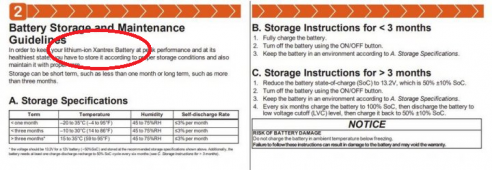Inq720
Odysseus, expert on the Siren's call
I've skimmed through this thread, but its mainly about actually keeping the battery warm. I'm more interested in the why? And specifically... I'm wondering about storage. I'm on another boat forum and I share some of what I learn from this forum with them. Someone over there posted the excerpt below from a manual. I understand the battery needs to be kept above 32F for charging and 0F for use.

- If I'm storing it over the winter and have diligently drained it to 50% SOC by one estimate or to 13.15 volts (< 40% SOC) by another reference, can I not leave it out in the cold?
- Do I really need to keep it at 59F?
- Is this some company being overly conservative?
- Or could this be a company supplying an excuse to void a warranty if someone didn't keep their batteries warm?
- If, it is a valid concern, what is the basis (mechanism) for this?
- Are we talking about cutting the life in half, or 1%?




